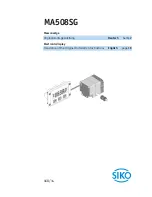
55
9 000 rpm
6 000 rpm
3 000 rpm
1 800 rpm
Figure 22
Speed Chart
Figure 23
5. Align the belt along the appropriate pulley grooves.
6. Push up the Motor Tesion Lever(b) and tighten the Allen
Bolt(a). When the belt is properly tensioned,there should be
approximately 1⁄4" of deflection in the center of the belt when
you press it with moderate pressure.
7. Tighten all the adjusting bolts.
8. Spin the pulley by hand to ensure proper tracking.
9. Close the door.
5.2 Replace V-belt
See above chapter.
5.3 Adjust the height of Spindle
WARNING! Perform this adjustment must switch off
the power first.
1. Loosen the Spindle Height Lock(a).
2. Make sure the fence & table cleaning with milling tool.
3. Move the spindle up or down with the Spindle Height
Handwheel (b) until the desired position is obtained.
To raise = turn counter-clockwise
To lower = turn clockwise
Any height adjustment can be read directly from the scale(c).
4. Secure the Spindle Height Lock(a).
Figur 24
Figur 25
Reversing switch
Main switch
5.4 Spindle Tilt Setting
WARNING! Perform this adjustment must switch off
the power first.
Using the Tilting table ring!
1. Loosen the Spindle Bevel Lock (a)
To loosen = turn counter-clockwise
To lock = turn clockside
2. Make sure the fence & table cleaning with milling tool. And
sesure that if the spindle tilted, it can touch the fence and table
ring.
3. Move the spindle bevel with the Spindle Tilting Handwheel (b)
until the desired position is obtained.
To right = turn leftside
To left = turn rightside
4. Secure the Spindle tilt Lock
5.5 Rotation
C
AUTION. Always check the direction of cutter rota-
tion before b eginning any milling operation.
!NOTICE. This machine was designed to be started and stop-
ped with the Main Switch (No-volt Release) – not the reversing
switch.
This machine is equipped with ad FORWARD/REVERSE switch
as shown in (F/R -
Figure 25)
. In many instances, you will find it
necessary to flip the cutter over and reverse cutter rotation.
Whenever possible, mount the cutter so the board is milled on the
bottom side. This method does a better job and is safer for the ope-
rator.
CAUTION. Before turning the Reversing Switch, must
switch off the power and wait the machine standstill.
The reversing switch turns left, the machine is running at forward
mode, the spindle is running counter-clockwise. The reversing
switch turns right, the machine is running at reverse mode, the
spindle is running clockwise. These functions are also called ordi-
nary milling (Figure 1). The usual way of milling, i.e. the milling
cutter rotates against the feeder direction (= the direction in which
the work piece is put against the milling cutter) or unidirectional
milling (figure 2), the milling cutter rotates in the feeder direction.
NB! For safety purposes, unidirectional milling may only be per-
formed if the machine is equipped with a so-called feeder unit,
which is fitted into specially designated screw holes on the platen.
It is absolutely not permitted to manually feed the work piece (wit-
hout feeder unit) when using the unidirectional milling function.
Feeder direction
Rotation direction
of the milling tool
Milling block
Figure 1 Ordinary milling
Содержание 20463-0305
Страница 2: ......
Страница 107: ...105 ...
Страница 109: ...107 ...
Страница 111: ...109 ...
Страница 114: ...112 ...
Страница 119: ......
















































